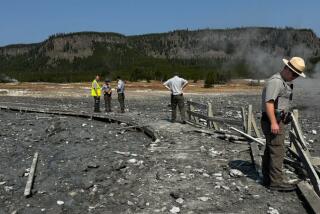Grizzly Population in Park Bears More Study
- Share via
DENVER — One of the most dramatic successes of the Endangered Species Act in the last quarter-century is unfolding in Yellowstone National Park, but scientific controversy and environmental politics are clouding the achievement.
In 1982, the data available to biologists indicated that grizzly bears would be extinct in the park by 2000. The bear received protection under the Endangered Species Act, and now bear populations in the greater Yellowstone ecosystem appear to be healthy and growing.
Mark Boyce, a University of Wisconsin-Stevens Point biologist, said: “There is good evidence that bears in the park are saturated.” Bears are sighted farther and farther from Yellowstone each year, Boyce said, and within the park, it appears that grizzlies have taken up residence in most of the available habitat.
Chris Servheen of the U.S. Fish and Wildlife Service contends that “the population is increasing more than 4% per year,” about the maximum that can be expected.
But environmentalists are fearful of the ripple effects of such findings, particularly on their efforts to contain development in the region if the grizzly population is deemed to be officially “recovered.”
Louisa Willcox, a longtime grizzly activist, said: “I would conclude that the bears in the Yellowstone ecosystem are not doing particularly well.” She cites the work of Craig Pease of the University of Texas and Dave Mattson of the University of Idaho, who contend that at best the bear population is stable. “The government is claiming that there are 2 1/2 times as many bears as there were 20 years ago. Our analysis says that there’s the same number,” Pease said.
*
Protection of the bear under the Endangered Species Act is the strongest way to ensure that its habitat continues to be protected. The stakes are high, since the grizzly range also is home to big game herds and is a target for development.
Seventy percent of the 31,000-square-mile greater Yellowstone ecosystem is federal land. Of those 11.7 million federal acres, about 2.5 million are parks and 3.8 million are wilderness. Ninety percent of the rest is open to “multiple use” activities--oil and gas leasing, timber sales and housing. Such “multiple use” has been restrained because there is a limited amount of suitable bear habitat.
Steve French and his wife, Marilyn, oversee the longest-running Yellowstone bear research. French said that while the hard data for delisting the bear as an endangered species does not yet exist, “do I think they’re ready to be [declared] recovered? I think they are.”
The density of bears is already creating some of the classic human-wildlife conflicts that have given the Endangered Species Act a bad image. On one cattle lease, as many as 13 different grizzly bears have been identified and some have killed calves.
French suggests selling limited hunting licenses and using the money raised for bear conservation. “If you say, OK, let’s have a lottery for a limited harvest of one to four bears . . . put that up for auction. Can you imagine what a grizzly bear tag would go for? A bighorn sheep tag goes for $50,000 to $100,000. You remove a bear that would be removed prematurely anyway. . . . You’re not changing the population dynamics that much.”
But such a proposal could not be implemented without changing the bears’ status under the Endangered Species Act.
More to Read
Sign up for Essential California
The most important California stories and recommendations in your inbox every morning.
You may occasionally receive promotional content from the Los Angeles Times.










